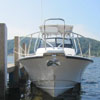|
Tackle Tray System Mold
|
| Royboy |
Posted on 05/13/07 - 6:26 AM
|

Member
Personal Page
Posts: 127
Comments:
2
Joined: 04/23/07
|
I'm building a tackle tray system for my 17 Outrage II to get my tackle off the deck. I've got the mold mostly built (see photo), but a couple of hurdles remain. http://smg.photobucket.com/albums/v40...G_1241.jpg Note that there is 2 degrees of draft on all surfaces so the finished part will slide off of the mold. Prior to laying up the gel coat, the entire mold will be sanded smooth, sealed, and then covered with a parting compound, in this case paste wax followed by PVA.
First, I need to complete fillets on the mold to round off all of the corners on the finished part. Normally, these would be made by melting wax strips into all of the female corners with a hot fillet iron (a steel ball mounted on a steel rod). I don't have any of these wax strips and they cost around $25 for enough of them to do this job, and I'm trying to keep costs at a minimum. Also, wax fillets are not all that durable, and I'd like to be able to take multiple parts off this mold with a minimum of rework between shots. I'm experimenting with plastic wood, but it's less than ideal to work with.
Second, I need to find a suitable flocking material to dust onto the wet gell coat so that subsequent layers of resin will adhere properly. I'm thinking milled cotton would be a good choice, but I can also just rough up the hardened gel coat with sandpaper. This is effective, but also a lot of work.
Edited by Royboy on 05/16/07 - 1:46 PM |
| |
|
|
| Joe Kriz |
Posted on 05/13/07 - 11:38 PM
|

Site Owner
Personal Page
Personal Album
Photo Albums
Project Albums
Posts: 11447
Comments:
452
Joined: 03/18/05
|
Roy,
I couldn't get your link above to work.
Try these links:
http://img.photobucket.com/albums/v40...G_1241.jpg
http://img.photobucket.com/albums/v40...G_1240.jpg
http://img.photobucket.com/albums/v40...G_1239.jpg
Your link does not seem to work with the "?action=" part.
Your photos remind me of my old pattern making days.
We used the wax fillets exclusively in those days but our patterns were traced from metal cutting machines to produce a copy made of steel.
I just thought of something instead of wax.
What about buying some hard plastic or nylon weather strip molding with the right radius?
Edited by Joe Kriz on 05/13/07 - 11:47 PM |
| |
|
|
| Royboy |
Posted on 05/14/07 - 4:36 AM
|

Member
Personal Page
Posts: 127
Comments:
2
Joined: 04/23/07
|
I think I've got the link fixed, thanks Joe. I ended up using wood filler for the fillets, but caulk might have worked as well. I was a patternmaker years ago, as was my father and grandfather. I think they are hard to find today.
I'll be getting the mold ready for laying up the plastic this week. I'll try to capture the steps in photos and post them, including (hopfully) the installation on my Outrage.
|
| |
|
|
| Royboy |
Posted on 05/15/07 - 10:30 AM
|

Member
Personal Page
Posts: 127
Comments:
2
Joined: 04/23/07
|
I ended up using a latex wood filler for the fillets. Also, West Systems 403 Microfibers fits the bill for a suitable flocking material.
After sanding the whole mold down with 100, then 180, then 400 grit sandpaper, I applyied several more coats of sanding sealer. After this had thoroughly dried, I applied two coats of paste wax, buffing out each coat to a high shine. I then coated the whole mold with the mold release, that turns out to be PVA after all. It woked very well, laying down with a minimum of brush strokes.
I let the PVA dry overnight, and then mixed up my gel coat with a dot of brown pigment to get a nice light tan (off white might be a better description) shade. After adding hardener, I mixed for one minute then painted the mixture liberally onto the mold. Note the fillets in these pictures.http://smg.photobucket.com/albums/v40...G_1242.jpg http://smg.photobucket.com/albums/v40...elcoat.jpg
As soon as I finished the gel coat I flocked the entire job with West Systems 403 Microfiber. In the pictures there are a lot of "crumbs" of microfiber, but the whole job is finely dusted with the tuny fibers as well. These are the desired "flocking" to ensure good adhesion of the next coat.http://smg.photobucket.com/albums/v40...ncoats.jpg
Edited by Royboy on 05/16/07 - 1:49 PM |
| |
|
|
| Jeff |
Posted on 05/15/07 - 10:37 AM
|

Member
Posts: 1987
Comments:
34
Joined: 04/02/05
|
Roy,
Nice work. What is your final part going to be made of, glass or are you going to vac form plastic?
1993 23' Walkaround Whaler Drive |
| |
|
|
| Binkie |
Posted on 05/15/07 - 11:49 AM
|

Member
Personal Page
Posts: 2012
Comments:
0
Joined: 12/19/05
|
Roy,
This flocking is new to me, I never used it before. It makes the outer gell coat adhere to the fiberglass?. It looks like the plug or mold is screwed to the sheet of plywood. When its done your going to pull the finished part off the plug, I guess?
Rich
|
| |
|
|
| Royboy |
Posted on 05/15/07 - 2:01 PM
|

Member
Personal Page
Posts: 127
Comments:
2
Joined: 04/23/07
|
The flocking makes the otherwise glossy gel coat fuzzy. When the next coat goes on it will stick to all that fuzz forming an excellend bond between the two coats. It works for any glossy epoxy that will get another coat. The alternative is roughing up the surfaces with sandpaper.
I'm laying up glass with polyester resin over the gel coat, and then when hard, the whole thing will pop right off of the mold (hopefully) with the aid of a few wedges. I'll have to remove the small dam around the perimeter of the flange to get the wedges under it. I'll take some pictures as I do it, but right now it's hardening.
|
| |
|
|
| Royboy |
Posted on 05/16/07 - 1:59 PM
|

Member
Personal Page
Posts: 127
Comments:
2
Joined: 04/23/07
|
Here is a link to a picyure with the resin a fiberglass layed up: http://smg.photobucket.com/albums/v40...mplete.jpg
It was a bit harder to remove from the mold than I would have liked, but it did come off in one piece, albiet with a few minor cracks. I don't think this one is "good enough" for my boat, but I'll make the final determination when it's all cleaned up. Although the cracks don't go "all the way through", they are still unsightly. When I have to ask myself if something is "ggod enough" for my Whaler, it usually isn't.
I'm thinking it may have been too ambitious to cast in the dividers between the trays. If I make a plug with no dividers, I can add them to the part with starboard and screws. It will make the mold a whole lot more versatile, and eliminates the tricky areas. Anyway, here is the part with the mold removed and most of the mold release washed off:http://smg.photobucket.com/albums/v40...emoved.jpg and another view showing the cast "dividers" a little better: http://smg.photobucket.com/albums/v40...G_1279.jpg
At the very least, this will be a good prototype I can use to get the frame, door, and associated hardware sorted out. More to follow...
Edited by Royboy on 05/16/07 - 2:02 PM |
| |
|
|
| Royboy |
Posted on 05/20/07 - 6:08 AM
|

Member
Personal Page
Posts: 127
Comments:
2
Joined: 04/23/07
|
The decision is made: I have filled in the tray supports on the mold and will cast a plain "tub". The previous part is "not good enough" for my Whaler.
|
| |
|
|
| Binkie |
Posted on 05/20/07 - 8:57 AM
|

Member
Personal Page
Posts: 2012
Comments:
0
Joined: 12/19/05
|
Roy,
I read some time ago in a book on building fiberglass molds that the sides should never be 90 degrees from each other. It said that for ease in removing the part from the mold to make the sides no less than 85 degrees. I noticed this to be true, and of course boat hulls sides are flared out for obvious reasons, other than to make the hulls easy to remove from the mold. For a visual description, it would be easier to pull the mold off a pyramid that a box with vertical sides.
Rich
|
| |
|
|
| Royboy |
Posted on 05/20/07 - 10:53 AM
|

Member
Personal Page
Posts: 127
Comments:
2
Joined: 04/23/07
|
It's called "draft" and my mold has two degrees on all surfaces. It's not all that apparent in the photos. Five is really too much. You want the release agent to shear. Anywhere from a half degree to two degrees is all that's needed. My mold had trouble with the fillets dragging in the tight spaces between the trays. If I had used wax fillets I could have avoided this problem.
|
| |
|
|
| Binkie |
Posted on 05/25/07 - 5:53 PM
|

Member
Personal Page
Posts: 2012
Comments:
0
Joined: 12/19/05
|
Roy, Have you completed the project?
Rich
|
| |
|



